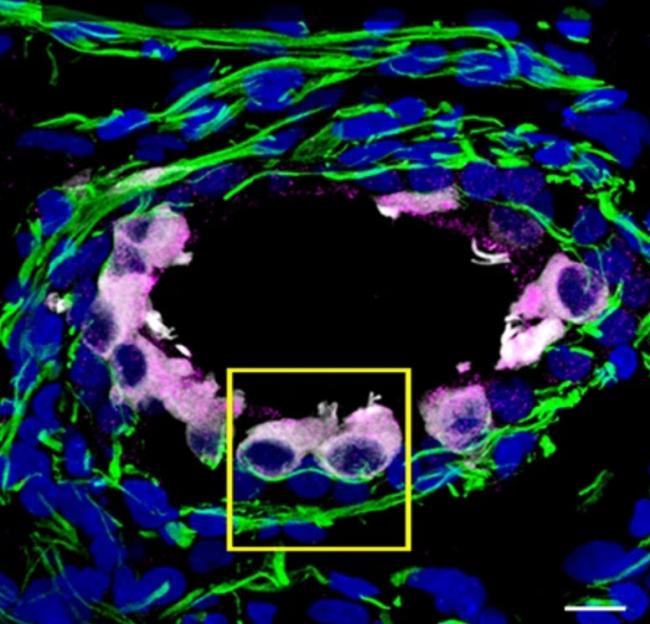SARS-CoV-2 infection of the inner ear
November 9, 2021
SARS-CoV-2 infection of the inner ear
At a Glance
- Researchers found that SARS-CoV-2 can infect inner ear cells.
- Inner ear viral infections could explain the hearing and balance issues in some COVID-19 patients.

Sensory symptoms, including loss of taste and smell, sometimes come with COVID-19. Hearing and balance symptoms associated with COVID-19 have also been reported, but these have not been thoroughly studied. Hearing loss and balance disorders often result from viral infections in the inner ear. But the effects of SARS-CoV-2, the virus that causes COVID-19, on the ear remain poorly understood.
A team of researchers led by Drs. Lee Gehrke at the Massachusetts Institute of Technology and Konstantina Stankovic, now at Stanford University School of Medicine, examined hearing and balance symptoms in patients with COVID-19. They also studied inner ear tissue and cells to determine the virus’s effects. NIH’s National Institute of Allergy and Infectious Diseases (NIAID) supported the research. Results appeared in Communications Medicine on October 29, 2021.
The researchers identified ten patients with COVID-19 who developed hearing loss after infection. The hearing loss ranged from mild to profound. Nine of the patients also experienced tinnitus, a ringing or buzzing noise in one or both ears. Six patients experienced vertigo, a sudden spinning sensation. The timing of symptom onset suggested a correlation between COVID-19 infection and hearing loss.
To find out how COVID-19 might cause these symptoms, the team collected inner ear tissue from patients who’d had surgery to treat severe vertigo. None of these donors had COVID-19.
Infection by SARS-CoV-2 requires certain proteins on the host cell surface. The researchers found these proteins on two types of inner ear cells—hair cells and Schwann cells. The former sense sound waves for hearing and motion for maintaining balance. The latter provide electrical insulation for nerve cells. SARS-CoV-2 could infect both of these cell types in the lab.
Human inner ear tissue is difficult for researchers to get. So, the team developed models of inner ear tissue that they could use for further investigation. They took cells from human skin that were reprogrammed to become stem cells. They then directed the stem cells to develop into precursors of either hair cells or Schwann cells.
Like the human inner ear samples, these cells had the proteins needed for SARS-CoV-2 infection. SARS-CoV-2 infected the hair cell precursors and, to a lesser extent, the Schwann cell ones.
The team obtained similar results from experiments in inner ear organoids. These are 3D tissues generated from stem cells. They mimic not only the types of cells in the inner ear, but also their spatial organization and function. Hair cell- and Schwann cell-like cells in these organoids had the proteins needed for SARS-CoV-2 infection. The virus was able to infect the hair cell-like cells in the organoids.
Together, these results point to SARS-CoV-2 infection of the inner ear as a cause of COVID-19-associated hearing and balance issues.
In addition, Gehrke says, “this work opens a path now for working with not only SARS-CoV-2 but also other viruses that affect hearing.”
—by Brian Doctrow, Ph.D.
Related Links
- A Blueprint of Cell Development in the Inner Ear
- Technique Forms Working Inner Ear Cells
- Dealing With Dizziness: Getting Help for a Balance Disorder
- Ringing in Your Ears? Get the Buzz on Tinnitus
- Hearing, Ear Infections, and Deafness
- Balance Disorders
- Tinnitus
- COVID-19 Research
- Coronaviruses
- About COVID-19
References
Direct SARS-CoV-2 infection of the human inner ear may underlie COVID-19-associated audiovestibular dysfunction. Jeong, M., Ocwieja, K.E., Han, D. et al. Commun Med 1, 44 (2021) Oct 29. https://doi.org/10.1038/s43856-021-00044-w.
Funding
NIH’s National Institute of Allergy and Infectious Diseases (NIAID) and National Institute on Deafness and Other Communication Disorders (NIDCD); Nancy Sayles Day Foundation; Barnes Foundation; Remondi Family Foundation; Sheldon and Dorothea Buckler; Bertarelli Foundation.


